In Spain last week I found this simple infant book and this led mt to think of a creative idea.....that could be really useful to practise opposites with LKS2!
The book in itself is a marvellous joining in text to practise opposites.The children can swivel the objects in the middle of the hard card page, can anticipate the opposite phrase used with the next page.You can revisit the book and play anticpation or memory games too.
This made me think of "twizzle stick opposites"!
All we are going to need are lolly sticks,firm card, glue and seloptape,oh and some scissors!
First a little bit about the book!
The book shows a picture of an item on each page and and a key word.It's opposite word and the same picture( but drawn to convey the new meaning) are shown on the reverse side of the page.The picture inbetween can be swivelled to match the key word .For example there is a smiley face with "contento" above it and when you swivel the face it is a sad face on the other side and reads "triste"
The pictures can be turned over or swizzled around! Just like this tortoise it can be "derecha" or can be flipped around and on the next page "izquierda"
Twizzle Stick Opposites Game
- This is my way of creating an interactive game to practise opposites using a physical activity.
- Year 3 or 4 could create the twizzle sticks and share with KS1.
- It will also help the Y3/4 children have a better understanding of the concept of "opposites" plus a physcial and visual memory of key words to describe or place objects.
- I anticipate that each child should make 5 swizzle sticks and therefore explore the meaning of 10 words in 5 pairs of opposites.
- The twizzle sticks can just have opposites written on them or could also have the nouns of ther objects the children have used too, hidden under a lift and reveal flap.
Making Twizzle Sticks
- Ask the children to think of 5 pairs of opposites in English
- Can they now find these woirds in the bilingual dictionary and cross reference their meaning in the front of the bilingual dictionary to check its meaning.(This could be a pair activity where the partner cross reference words and feeds back what they find)
- The children need to write each word out in the target language on a separate small strip of firm card.
- The children can now put the words with their opposite word in to 5 piles of opposite words e.g contento/triste or izquierda/derecha
- For each pair of opposite words the children now need to think of an object that they can draw and use to explain both of the opposite words.For example with contente/triste - this will probably be the face of a child/person/animal etc or maybe with directions it could be a vehicle.
- The children should draw the objects (twice per twizzle stick) so that the images of the objects conveys the meaning of the opposite words .
- The drawings needs to be attached with glue or selotape to the top third of the lollipop stick and the correct opposite word card that they have chosen and written out needs to be glued or selotaped below the correct image of the object.
- Each child shares with a partner all the twizzle sticks they have made and say the opposite word as they show each of the images.They will need to twizzle their sticks to share all the images and the opposite words
- the first child lays out their sticks on the table with one side of the twizzle stick showing.
- The second child selects a twizzle stick , picks it up says the word that is face up on the stick, anticpates and says the opposite word and then twizzles the stick to see if he/she was correct.
- If he/she is correct then the stick now belongs to the second child.
- Which child wins the most sticks from am partner?
- Add extra challenge by giving each child a strip of coloured paper long enough to place across the five twizzle sticks of one player.The strip of paper should not conceal the picture but should conceal the face up word.
- Who can now remember the face up word and the opposite word written on the face down side of the stick?














































